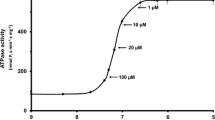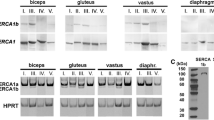Summary
Avian muscular dystrophy is an autosomal recessive genetic disease characterized by early hypertrophy and loss of function of the pectoralis major. The disease is progressive, ultimately resulting in atrophy and heavy lipid deposition.
Previous investigators have noted a decrease in the ability of the dystrophic sarcoplasmic reticulum to concentrate Ca2+. More recently, other investigators have shown an abnormal calcium uptake in avian dystrophic sarcoplasmic reticulum. They indicated, using freeze-fracture techniques, that a 90 Å particle of the vesicle membrane exhibited a decreased population and suggested that they might be the ATPase involved in calcium transport.
Our studies confirm the earlier observations of a decreased rate of Ca2+ uptake and Ca2+ binding capacity of dystrophic fragmented sarcoplasmic reticulum vesicles which are isolated from both embryonic and adult pectoralis. These observations correlate in turn with a 75% drop in the Ca: ATP transport efficiency of the dystrophic sarcoplasmic reticulum determined by measuring the rate of32Pi liberation from γ-ATP32 during active calcium transport by the isolated sarcoplasmic reticulum SR.
In addition, we have found a quantitative deficiency in a 65,000 dalton component of the dystrophic fragmented SR at the time of myoblast fusion by measuring35S-Methionine incorporation into the SR, coupled to high resolution polyacrylamide gel electrophoresis and radioautography. Analysis of total tissue calcium by atomic absorption spectroscopy revealed a decrease in the total calcium content of dystrophic muscle.
Similar content being viewed by others
References
Asmundson, V.S., Julian, L.M. 1956. Inherited muscular abnormality in the domestic fowl.J. Hered. 47:248
Berridge, M. 1975. The interaction of cyclic nucleotides and calcium in the control of cellular activity.In:Advances in Cyclic Nucleotide Research. G. Drummond, P. Greengard and G. Robinson, editors. Vol. 6, Chapter 1. Raven, New York
Botelho, S.Y., Beckett, S.B., Bendler, E. 1960. Mechanical and electrical responses of intact muscles to indirect stimuli: Study of patients with pseudohypertrophic muscular dystrophy.Neurology 10:601
Buchthal, F., Kamieniecka, Z., Schmalbruck, H. 1974. Contraction times and fiber types in intact human muscle.In: Exploratory Concepts in Muscular Dystrophy II. A.T. Milhorat, Editor. pp. 526–554. Exerpta Medical Foundation, Amsterdam
Desmedt, J.E., Hainaut, K. 1968. Kinetics of myofilament activation in potentiated contraction: Staircase phenomenon in human skeletal muscle.Nature (London) 217:529
Madeira, V. 1975. A rapid and ultrasensitive method to measure Ca++ movement across biological membranes.Biochem. Biophys. Res. Commun. 64(3):870
McComas, A.J., Thomas, H.C. 1968. A study of the muscle twitch in the Duchenne type muscular dystrophy.J. Neurol. Sci. 7:309
Peter, J.B., Worsfold, J., Fiehn, W. 1974. Kinetic characteristics of fragmented sarcoplasmic reticulum from normal and diseased human skeletal muscle.In:Exploratory Concepts in Muscular Dystrophy II. A.T. Milhorat, Editor. pp. 491–498. Excerpta Medical Foundation, Amsterdam
Roe, R.D., Yamaji, K., Sandow, A. 1967.In: Exploratory Concepts in Muscular Dystrophy and Related Disorders. A.I. Milhorat, Editor. pp. 299–304. Excerpta Medica Foundation, Amsterdam
Sabbadini, R., Scales, D., Inesi, G. 1975. Ca2+ transport and assembly of protein particles in sarcoplasmic membranes isolated from normal and dystrophic muscle.FEBS Lett. 54(1):8
Samaha, F.J., Gergely, J. 1969. Biochemical abnormalities of the sarcoplasmic reticulum in muscular dystrophy.N. Eng. J. Med. 280:184
Streter, F.A., Ikemoto, N., Gergely, J. 1967.In:Extraploratory Concepts in Muscular Dystrophy and Related Disorders, A.T. Milhorat, Editor, Excerpta Medica Foundation Amsterdam, pp. 289–298
Sugita, H. 1965. Enzymological study of progressive muscular dystrophy.J. Jpn. Soc. Int. Med. 54:744
Sugita, H. 1965. Some new findings on progressive muscular dystrophy.Adv. Neurol. Sci. (Tokyo) 9:393
Takagi, A., Schotland, D.L., Rowland, L.P. 1973. Sarcoplasmic reticulum in Duchenne muscular dystrophy.Arch. Neurol. 28:380
Tonomura, Y. 1973.In: Muscle Protein, Muscle Contraction and Cation Transport. Chapters 11, 13, 14. University Park Press, Maryland
Author information
Authors and Affiliations
Rights and permissions
About this article
Cite this article
Ettienne, E.M., Singer, R.H. Ca2+ binding, ATP-dependent Ca2+ transport, and total tissue Ca2+ in embryonic and adult avian dystrophic pectoralis. J. Membrain Biol. 44, 195–210 (1978). https://doi.org/10.1007/BF01944221
Received:
Revised:
Issue Date:
DOI: https://doi.org/10.1007/BF01944221




